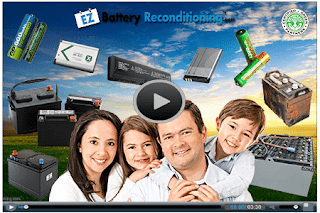Renovate A Lead Acid Battery - Sulfation is the Enemy of Lead-Acid Type Batteries
The cause - the process of sulfating in the "Cell" plates
In normal chemical reactions when an electric battery is discharged, lead lead sulfate crystals are deposited on the plates.In charging mode, they are transferred back to the active substance.
The discharge process takes place if there is a device that consumes electricity between two battery poles, the following chemical reaction occurs:
- At the anode: 2PbO2 + 2H2SO4 = 2PbSO4 + 2H2O + O2
- At cathode: Pb + H2SO4 = PbSO4 + H2
The discharge process ends when PbO2 at the anode and Pb at the cathode completely converts to PbSO4.
The process of charging the battery, due to the effect of the charging current on the inside of the battery, will have the opposite reaction to the direction of the reaction, the general reaction in the whole tank will be:
2PbSO4 + 2H2O = Pb + PbO2 + 2H2SO4.
At the end of the charging process, the battery returns to its original state: The anode consists of: PbO2, the negative pole is Pb.
If the battery is left for a long time, or only partially charged for a certain period of time, the lead sulfate crystals become hard and cannot be converted back into lead or lead oxide during charging. This may seriously affect the battery life, performance and capacity, so it is important to fully charge the Battery after each discharge and follow the manufacturer's instructions for voltage settings. Reasonable charging because the charging voltage is only slightly lower than the indication may still cause problems. Learn more: How To Recondition A Lead Acid Battery
The good news is that sulfation can often times be reversed. A specialized battery charger that pulses a high current through the battery is often used.
This allows the crystalline lead sulfate to be broken down and turned back into lead and sulfuric acid, thus cleaning the lead plates and regaining charge capacity.
Renovate a lead acid battery
#0. Identify the bad cells:-- Charge your batteries beforehand for at least 12 hours. After that, disconnect batteries from chargers and allow them to rest for 10 minutes.
- Open up all battery caps. If you have sealed lead acid batteries, search in the web for guides on how to open their caps.
- Fill up each compartment to within optimum water levels. This is crucial because in later parts, sparks will be produced and the air column in the compartments which contain hydrogen and oxygen can explode and blow the acid on your face. The higher the water level, the less the explosive air column, and the less likely for explosion to occur on your occasions. Use torch to aid observing water level meniscus.
- Measure the terminal voltage of battery (12v). Fully-charged battery must be in 12v range around 11.8v to 13.0v. If you have something lower than 11.8v, there is a very high chance of cell imbalance in which one of the cells (out of 6 cells) has a problem.
- Measure the voltage of each cell and identify the cells with lower voltages. Attach multimeter probe to one of the terminals and immerse another probe into the cell solution. Continue along the cell holes. A good cell must have at least 2v. Remember the bad cells and note that they would have different colors of plate than other cell plates because of heavy thick formation of lead sulphate crystals which are non-conductive.
#1. Below are the methods for the process of De-sulphation:
- Attach a battery trickle charger or a computerized smart charger to your old lead acid battery, and allow charging continuously for about a week to 10 days. The extremely slow charging rates dissolve the de-sulphation that kills the battery, and revives it back to being able to hold a usable charge.
- Wire in an electronic de-sulphate device that constantly de-sulphates the battery acid solution. These are available as either ready-to-use units, or they can be built from a kit.
- Add a chemical desulphator to the filling ports on an old lead acid battery. The chemical dissolves the sulphation, and revives old and new batteries alike.
#2. There are certain preventive measures which should be taken before performing the above steps yourself:
- Must wear goggles and gloves while working with lead acid batteries.
- The electric cells and plates in an old battery must be sound and functional. If these vital components of a battery are damaged in any way, your old lead acid battery will never revive.
The Battery Reconditioning Guide will show you everything you need to know about repairing and rejuvenating dead batteries. Whether they're lead-acid, nicad, or nimh batteries, they can most likely be repaired. Not only can you save money doing this, you can easily Make Money by reconditioning batteries for others. And the best part is that it's inexpensive to do.
Maybe you like it:
- Causes of major damage and storage of batteries in the UPS system
- What type of homemade AC generator is best?
- How can Make Free Energy Generator
- Bringing Dead Batteries Back To Life Is Simple!
Renovate A Lead Acid Battery - Sulfation is the Enemy of Lead-Acid Type Batteries
 Reviewed by Re-programming Life
on
10:08 AM
Rating:
Reviewed by Re-programming Life
on
10:08 AM
Rating:
 Reviewed by Re-programming Life
on
10:08 AM
Rating:
Reviewed by Re-programming Life
on
10:08 AM
Rating:










ReplyDeleteBattery chargers for cars keep your car charged and help avoid the risks associated with getting stranded by a car that wont start. this will cause you to be late for work, miss appointments, and incur other expenses associated with getting your car started.
professional battery manufacturer